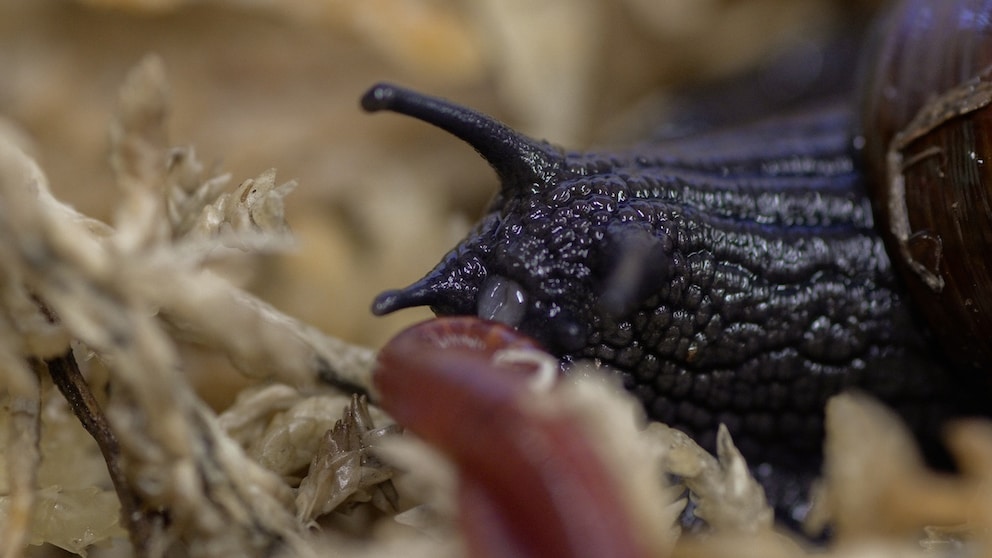May 14, 2025, 12:04 pm | Read time: 3 minutes
A moment as rare as it gets: One of the world’s largest snails is filmed for the first time laying an egg—from an opening in its neck. The spectacular scene was captured by chance but holds immense value for species conservation.
The New Zealand environmental agency Department of Conservation (DOC) has filmed for the first time a rare carnivorous snail of the species Powelliphanta augusta—also known as the Mount Augustus snail—laying an egg through an opening in its neck. The unusual moment occurred during a routine weight check of the animals, which are kept in captivity due to acute threats. Suddenly, a small, white object emerged from the snail’s neck region.
Decades-Long Conservation Project Aims to Save Endangered Snail
The Mount Augustus snail is one of the largest land snails in the world. It can reach about the size of a golf ball, grows very slowly, and can live for several decades. In captivity, some specimens have lived for 25 to 35 years. Their diet consists of earthworms and slugs, which they reportedly suck up like spaghetti, according to DOC. 1
During a routine examination of snails in Hokitika on New Zealand’s South Island, the surprising event was documented: An egg visibly emerged from the body of the endangered Mount Augustus snail. This alone would be remarkable enough for a species that has been almost entirely deprived of its natural habitat. However, the snail laid its egg not just anywhere but from its neck.
The discovery is a milestone, as although the animals have been observed in captivity for nearly two decades, no egg-laying had been documented before. Kath Walker, senior scientific advisor at DOC, explained in a statement that the animals are hermaphrodites with a genital pore in their neck.
From Mountain to Refrigerator—Rescue Under Adverse Conditions
This anatomical peculiarity allows them to remain in their shell for reproduction: “It extends its penis from this pore into the pore of its partner, and its partner does the same, simultaneously exchanging sperm, which they can store until they fertilize the received sperm to produce eggs,” Walker said. This reproductive behavior is also observed in other snail species, although some give birth to live young.
Before the conservation project began, little was known about the lifestyle of Powelliphanta snails. Today, the conservation program is considered crucial for the survival of the animals. Since 2006, the agency has kept the endangered snail species in refrigerated containers. At that time, the mining company Solid Energy began to strip away their only natural habitat on the Mount Augustus ridge.

Ruling on cloned giant sheep in the USA

“Extremely Rare Event” Explains Why There Are Three Egg-Laying Mammals

Unique Sighting! Octopus Rides the Fastest Shark in the World
Snails to Be Reintroduced into the Wild
The approval of the project—despite massive protests and legal disputes—caused great public outrage at the time. About 4,000 snails were relocated to neighboring areas. Another 2,000 served as a breeding stock in captivity to maintain genetic diversity, aiming to prevent the species from extinction. A setback occurred in 2011 when around 800 animals died due to a technical defect in a DOC refrigerator.
In March 2025, according to the agency, there were 1,884 snails of all ages and 2,195 eggs in captivity. Additionally, conservationists established new colonies in the wild and continuously monitor their development to ensure the formation of stable populations.
Lisa Flanagan, a ranger with New Zealand’s Department of Conservation (DOC), has been overseeing the snail population for over twelve years. She reports: “It’s remarkable that in all the time we’ve been caring for the snails, we’ve never seen one lay an egg. I just love watching their progress every month, weighing them, seeing how their shells develop, and all the interesting things they do,” Flanagan said about her work with the snails, which she initially never expected.

